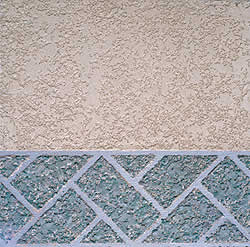
Concrete Stencil
Stenciling existing Concrete. Expand your business oportunities. Concrete could be a progressive painter's next frontier.
by Stacey Enesey Klemenc
ways to get a bigger piece of the proverbial pie may not have to look any farther than the patio … or the driveway … or the sidewalk. Stenciling existing pads of concrete to make them look like natural stone, brick or ceramic tile isn’t as tricky as you may think. And although it looks like stamping, it’s a whole different animal.
“The stamping process takes more skill and experience. You have to learn the timing of the concrete. There’s a certain window where you can work with the cement or it can get away from you,” says Gerry Sadleir, vice president of Concrete Solutions in San Diego. “With stencils, there’s no waiting for the right moment. You just spray and work them right away.”
The basic precept of applying a cementitious overlay isn’t that far from spraying paint or texturing a ceiling. Most painters should have the fundamental tools to perform the transformation. And once you get the knack, you’ll be able to convert an ordinary gray slab into a money-making venture that can put extra green into your pocket.
“It’s an excellent way to make concrete more creative and interesting,” says Sherry White, director of marketing for L.M. Scofield Co. “If something is worn and not attractive you can fill the cracks and put a textured topping over it to improve its appearance and durability. It’s also useful when you’ve got a structurally sound slab but something has happened before it completely cured and there are mars in the surface that didn’t get fixed.”
After repairing the flaws, she recommends putting down a thin layer of a color-matched cementitious topping (between 1⁄8 and 1⁄32 inch) that’s very quick curing. “Basically you’ll have something that looks as good as new without the pains of excavating. Plus, the toppings come in a whole range of colors so you can easily match existing treatments.”
Stencils on the market today range from herringbone, cobblestone and ashlar slate patterns to rosette, diamond and star compass designs that can be used in combination or singly over an entire slab or as an accent or border. In addition to in-stock offerings, custom stencils are available from a handful of companies in any design imaginable. Utah-based Stencil Systems, for instance, has created custom stencils for companies such as Harley-Davidson and John Deere. “We’ll create a border of dolphins if someone wanted to pay for it,” says company spokesman Clark Paepke.
Typically made out of plastic or a heavy coated paper, stencils come in large rolls for a one-time use or in smaller configurations for multiple use. Universal Templates Inc., for example, manufactures 15 different patterns available in 250- or 500-square-foot rolls while Stencil Systems offers 26 patterns in 1,076-square-foot rolls. The Sherwin-Williams Co., on the other hand, carries nine reusable stencil patterns, with eight of those available in two different sizes, 3-by-4 foot and 4-by-8 foot.
Stencils, which need to temporarily bond with existing concrete, can be bought with or without adhesive backing. The adhesive-backed varieties tend to be pricier than the noncoated ones for obvious reasons. “They save the contractor time and labor,” says Jerry Atwater with Universal Templates Inc. of his plastic adhesive-back stencils designed to be used with decorative concrete overlays.
Doug Burgan, owner of Spray Pave Utah Inc., says for smaller projects he finds it’s usually cheaper to buy noncoated stencils and use a 3M spray adhesive “no heavier than 70 — otherwise you’ll never get the stencil off the concrete” — or to use a sticky-back putty like the “blue tack” you can buy in grocery stores to make the stencil stay in place.
Scott Thome, director of product services for Scofield, cautions contractors to avoid a spray adhesive and use some sort of strapping or stenciling tape instead. “You need to be able to remove the stencil easily,” he says. “You don’t want to detract from the appearance by having glue on the concrete.” |

